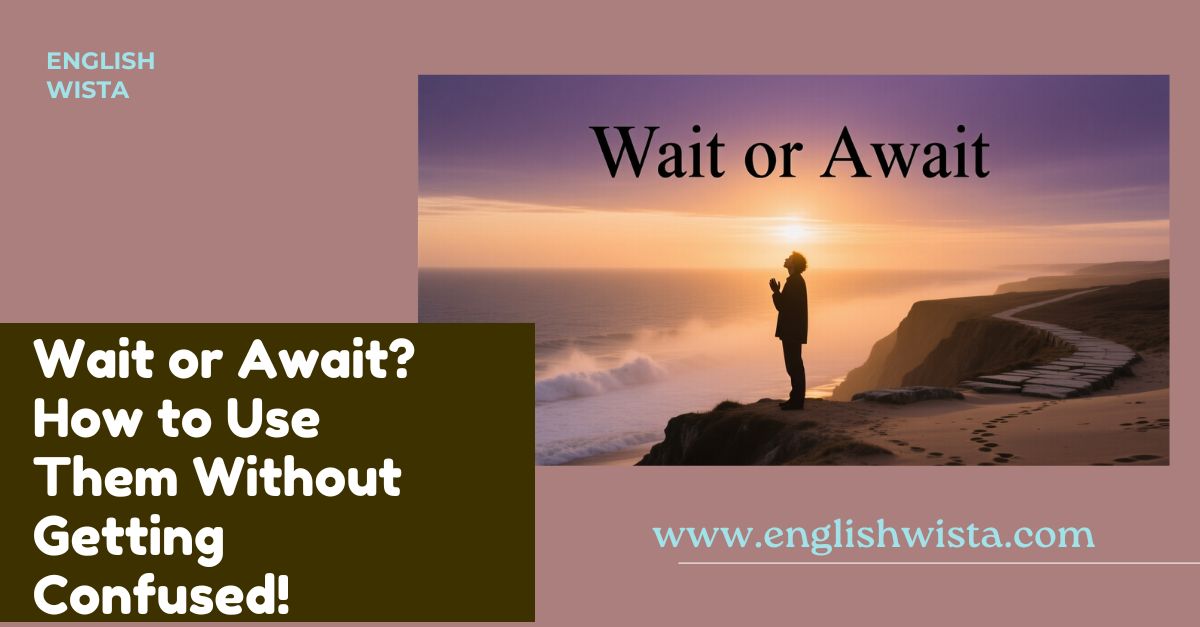Have you ever stopped mid-sentence wondering whether to say “I’m waiting for the bus” or “I’m awaiting the bus”? Don’t worry you’re not alone! Many English learners (and even native speakers!) mix up wait and await because they seem to mean the same thing. They both talk about expecting something or someone, right? True but the way we use them in sentences is a little different.
In this friendly guide, we’ll break down the difference between wait and await step by step. You’ll see how they work, when to use each one, and how to sound more natural when speaking or writing in English. So grab a cup of tea, relax, and let’s dive in!
What Does “Wait” Mean?
Let’s start with the more common word wait.
To wait means to stay in one place until something happens or until someone arrives.
In simple words:
Wait = Stay or pause until something happens.
Examples:
- I’m waiting for my friend to call me.
- We waited in line for an hour.
- Wait here until I come back.
As you can see, wait is used in everyday English, whether you’re talking about buses, friends, meetings, or even dinner!
What Does “Await” Mean?
Now, let’s look at await.
It means to wait for something, but it’s a bit more formal and often used in writing rather than casual conversation.
In short:
Await = Wait for something (in a formal way).
Examples:
- We eagerly await your reply.
- The soldiers awaited their orders.
- A big surprise awaits you!
See the difference? Await sounds more elegant, serious, or literary. You might see it in books, emails, or news reports but not so much in daily conversation.
Main Difference Between “Wait” and “Await”
Here’s the golden rule:
- Wait is followed by the preposition for.
✅ I’m waiting for my results. - Await is not followed by a preposition.
✅ I’m awaiting my results.
❌ I’m awaiting for my results. (Incorrect!)
So, when you use await, you skip for. Easy, right?
Let’s look at both words side by side:
| Example | Correct Usage |
|---|---|
| I’m waiting for the bus. | ✅ Correct |
| I’m awaiting the bus. | ✅ Correct |
| I’m awaiting for the bus. | ❌ Incorrect |
When Should You Use “Wait”?
You’ll mostly use wait in everyday situations and spoken English. It’s casual, natural, and fits almost any setting.
Examples:
- Can you wait for me?
- I’m waiting for the rain to stop.
- She waited outside the store.
Tip: If you’re chatting with friends, texting, or speaking casually wait is your best choice!
When Should You Use “Await”?
Use await when you want to sound a bit more formal or serious for example, in letters, announcements, or written messages.
Examples:
- We await your kind response.
- The results are eagerly awaited by the students.
- Justice awaits those who break the law.
Tip: If you’re writing an email, a report, or a story, await can make your writing sound more polished and professional.
Can You Use “Wait” and “Await” in the Same Sentence?
Sometimes, you can! But only if they have different meanings or actions.
Example:
- We are waiting at the airport, awaiting our flight.
Here, waiting shows that you’re spending time at the airport, and awaiting means you’re expecting your flight to be called.
So yes, they can appear together, but each has its own role in the sentence!
Common Mistakes to Avoid
- Using “for” after “await.”
❌ I await for your answer.
✅ I await your answer. - Using “await” in casual speech.
“I await the bus” sounds strange in conversation. Say:
✅ I’m waiting for the bus. - Using “await” with people directly (without context).
❌ I await you.
✅ I await your response / arrival / decision.
Await is used with events, results, or actions, not usually with people.
A Quick Trick to Remember
If you’re unsure which word to use, ask yourself:
Can I add “for” after it?
- If yes, use wait.
- If no, use await.
Example:
- I’m ___ for my friend. → “waiting for” fits! ✅
- I’m ___ my friend. → “awaiting” fits! ✅
Examples in Everyday Sentences
Let’s see both words in action:
Using WAIT:
- I’ll wait for you outside the theater.
- She waited patiently in the queue.
- We’re still waiting for the results to be announced.
- Don’t keep them waiting too long.
- Let’s wait until the rain stops.
Using AWAIT:
- We eagerly await your feedback.
- A bright future awaits those who work hard.
- The committee awaits the final decision.
- The nation awaits the election results.
- Surprises await you in the next chapter!
Is “Await” Older Than “Wait”? (A Little History!)
Here’s a fun fact!
Both words come from the same root. Wait comes from the Old English word “wæccan”, which meant to watch or stay awake.
Later, the French word “awaitier” (meaning to watch for or expect) influenced English to create await.
So, await is basically a fancier, French-influenced cousin of wait!
That’s why await sounds more formal it carries a bit of that old-fashioned charm.
Can “Await” Be Used Without an Object?
Usually, no. You need to say what is being awaited.
❌ We await. (Incorrect)
✅ We await the news. (Correct)
But wait can stand alone!
✅ We’ll wait.
✅ Wait here!
That’s another easy way to tell them apart await always needs an object, while wait doesn’t.
Are “Wait” and “Await” Interchangeable?
Not always!
They have similar meanings, but they don’t fit in all the same places.
- “Wait” can be followed by for, or used alone.
- “Await” is more formal, never uses for, and always needs an object.
Examples:
- ✅ I’m waiting for your call.
- ✅ I’m awaiting your call.
- ❌ I’m awaiting for your call.
So, while they sometimes overlap, the sentence structure decides which one works best.
Quick Practice: Can You Spot the Correct One?
Try to fill in the blanks!
- We are ______ the teacher to arrive.
- She ______ her turn at the counter.
- The company ______ your response.
- Let’s ______ until the rain stops.
- They ______ for the announcement to begin.
Answers:
- awaiting
- waited for
- awaits
- wait
- waited
A Fun Way to Remember the Difference
Think of wait as the friendly everyday word it goes with you to the bus stop, the cinema, or the café.
And think of await as the fancy word in a suit it belongs in letters, news headlines, or stories.
Examples:
- Everyday: “I’ll wait for your call.”
- Formal: “We await your response.”
Both sound great in their own places!
Idioms and Expressions with “Wait”
Let’s make learning a little fun! Wait appears in many English expressions.
1. Wait and see Be patient; time will tell.
Example: Just wait and see he’ll surprise everyone!
2. Can’t wait Excited about something.
Example: I can’t wait to see you!
3. Wait your turn Be patient; don’t rush ahead.
Example: Please wait your turn in line.
4. Wait it out Stay calm until a problem ends.
Example: We decided to wait out the storm.
Notice something? There are no idioms with await! That’s because await is too formal and doesn’t fit casual speech.
Why “Await” Feels More Formal
You might be wondering why does await sound so serious?
That’s because await is often used in official, written English, like:
- business letters,
- academic writing,
- or news reports.
It has a polite, professional tone.
Example:
“We await your kind reply” sounds more refined than “We’re waiting for your reply.”
So if you’re writing a formal email, await might be your best friend.
A Quick Recap
Here’s what you’ve learned so far:
- Wait = everyday, informal, used with for.
✅ I’m waiting for my friend. - Await = formal, no for, needs an object.
✅ I’m awaiting my friend’s reply. - Wait can stand alone.
✅ Just wait! - Await cannot stand alone.
❌ Just await! - Use wait in conversations, and await in formal writing.
Final Thoughts: Wait for It… (or Should We Say, Await It?)
Now you know the secret! The words wait and await may look and sound similar, but they live in slightly different worlds. Wait is the friendly, everyday word you use when chatting or describing simple actions. Await is its more formal twin best for writing, emails, and serious situations.
Whenever you’re unsure, remember this simple rule:
If the sentence feels formal and you don’t need “for,” use await.
For everything else, stick with wait.
And that’s it you’re now officially ready to use wait and await like a pro! So go ahead and practice these words in your next conversation or message. English is all about small choices that make a big difference.



